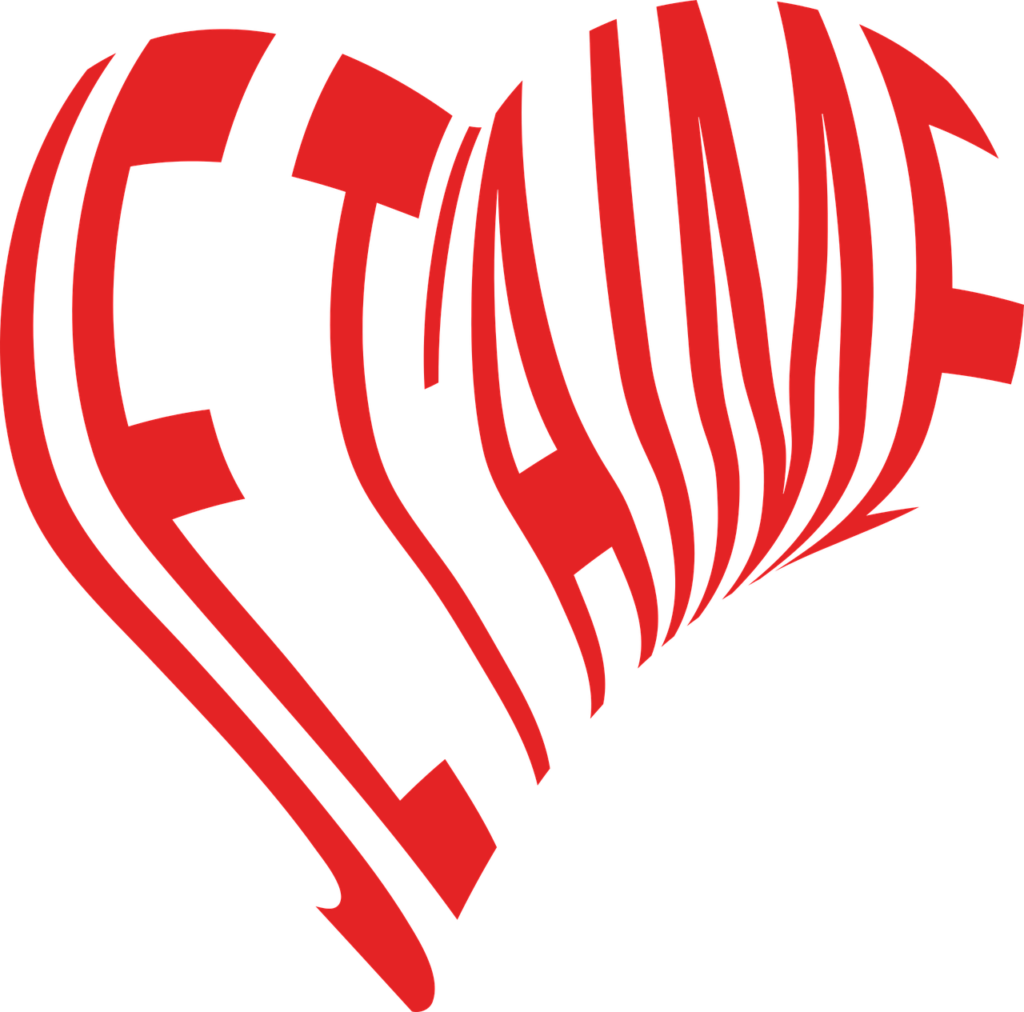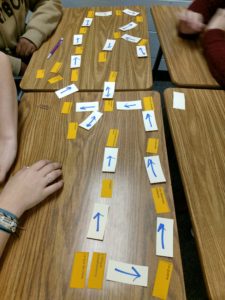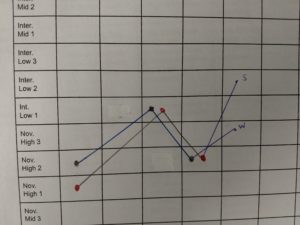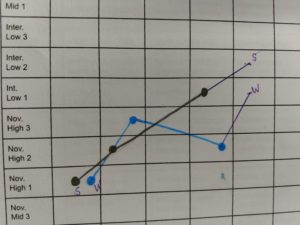 As some of you might know, I had the great honor of interviewing Laura Terrill, co-author of The Keys to Planning for Learning (purchase here) as part of a #langbook discussion on Twitter. (Our interview was featured in this podcast.) As I read the 2nd edition of this crucial text, one new understanding that I gained was the vital role that language functions play in teaching for proficiency. I definitely have not been intentional enough in creating opportunities for my students to communicate using various functions, so this was one of my goals in designing my latest unit for my French 4 and 5 students. Here’s a link (Updated 5/24/18: new link) to the agenda for the unit to which the resources I created are linked. A brief description of each lesson can be found below.
As some of you might know, I had the great honor of interviewing Laura Terrill, co-author of The Keys to Planning for Learning (purchase here) as part of a #langbook discussion on Twitter. (Our interview was featured in this podcast.) As I read the 2nd edition of this crucial text, one new understanding that I gained was the vital role that language functions play in teaching for proficiency. I definitely have not been intentional enough in creating opportunities for my students to communicate using various functions, so this was one of my goals in designing my latest unit for my French 4 and 5 students. Here’s a link (Updated 5/24/18: new link) to the agenda for the unit to which the resources I created are linked. A brief description of each lesson can be found below.
Lesson 1: Since the functions of Describing and Asking/Answering questions are typically the mainstays of my communicative tasks (along with a liberal sprinkling of Telling and Retelling Stories), I wanted to pay special attention to the functions of Expressing Feelings and Emotions and Expressing Advice, Opinions and Preferences in designing this unit. Here’s a link to the agenda with the resources for the unit I created with this goal in mind and here is a short description of each lesson:
Lesson 1: In order to introduce my students to a few aspects of sexual inequality in France, I’ll begin the first lesson by projecting a short infographic and leading a brief discussion about relevant cultural practices and perspectives in France and the U.S. Next, I’ll give the students a more detailed infographic and ask them to complete statements expressing their opinions and emotions about facts in their infographic in order to practice the structures they’ll need for these functions. After discussing their reactions to the infographic in small groups, they’ll listen to a video about La Journée de la Femme and respond by filling in a table with details they have understood.
Lesson 2: As a hook for this lesson, I’ll play and discuss a video about La Journée de la Femme. Next the students will listen to part of a video about the history of women’s rights in France and complete a manipulative activity in small groups. Next each student will be given one of two different infographics with important dates for women’s rights in France. After filling in a graphic organizer with their opinions of the most important events in this movement, they will discuss with a partner (who had the other infographic) in order to reach a consensus about the most important dates. I think this activity will provide an important opportunity for the students to engage in the function of Expressing Opinion.
Lesson 3: The hook for this lesson is a video about women’s rights in Tunisia that I will discuss with the class in order to provide background information about the perspectives of another Francophone culture. The students will then complete the manipulative for the second half of the history video before beginning work on a short written presentation about one of the women who played an important role in the women’s movement in France. In order to ensure that the students are focusing on expressing advice and opinions, I have chosen a prompt in which they are writing to the French postal system to nominate one of the women to be featured on a new stamp. After finishing their letters, the students will discuss their choice with a partner in order to try to convince each other that their woman is the most deserving. (Lessons 4 and 5)
In Lesson 6 I will assign the first summative interpretive assessment, an 1jour1actu article about the experiences of women from different generations. Because some of these students will be taking the IB exam, I have used used questions types that are part of this test in my assessment.
In lesson 7 I will turn the focus toward women’s experiences in the workplace. As a hook I’ll present a short video with women’s statements of their experiences and then an infographic with key dates. Next, I will send the students to a website with period videos related to different aspects of the women’s movement, along with the reactions of experts in the field. Although we’ll only be using the videos related to the workplace, there are a wealth of great videos related to other aspects of gender equality here. I’ll have the students select one of the videos to listen to and prepare a short commentary. The next day (Lesson 8) the students will present the video they selected, as well as their commentary, in a gallery-style presentation. Rather than a generic presentational rubric, I have created one that specifically addresses the extent to which the students presented their opinion of the video in order to ensure that they focused on this language function.
Lesson 9: After a short video hook, I will facilitate a brief whole-class discussion of French products, practices and perspectives illustrated in an infographic on sexism in the workplace. Students will then read an article about work equality from 1jour1actu and fill in a Cornell note-taking template. The questions they write will form the basis of a small group discussion on the article.
In Lesson 10, I will project an infographic on sexual harassment and discuss it with the students before assigning an A or B infographic to each student. Students will then discuss the information in their infographics in order to compare details in a “top hat” diagram. The students will then complete a table with information from a video about sexual harassment.
In Lesson 11, I will introduce other types of harassment by discussing an infographic and drawing. I will then have the students discuss a very short film on the topic of harassment at school. In order to facilitate their discussions, I have created an Edpuzzle and embedded discussion questions at various points in the film. The students will then annotate a short article about sexual harassment in Belgian schools and discuss it with their groups.
In Lesson 12 I will give the second summative interpretive assessment–an article about sexism in schools with IB-style questions.
In Lesson 13 I will have the students take a quiz on gender stereotypes (the same quiz I used in this lesson) and discuss their opinions of each item in order to select the correct answers. I’ll give a small prize to the pair with the most correct answers in order to encourage the opinion-giving. We’ll then go over the correct answers in class (this will not be a graded activity). We’ll continue with the topic of gender-based stereotypes in Lesson 14 by completing a short comprehension guide on the answers to the previous day’s quiz and then taking a formative assessment on a video about stereotypes (or playing FluentKey Live as a class).
In Lesson 15 we’ll look at Tweets in which people express how their lives would be different if they were of the opposite gender. (Finding PG-rated Tweets on this topic was not as easy as it sounds!) The students will then read and fill in a comprehension guide about an article on the same topic. Next, the students will write a paragraph of their own expressing how they think their lives would be different if they were a member of the opposite sex.
In Lesson 16, I will have the students sign-up to present one of the political cartoons I have curated about gender inequality. The students will answer a series of guiding questions about their cartoon. In Lesson 17 they will present their caricatures, gallery-style, to their classmates.
In Lesson 18 the students will complete the final summative assessments of the unit. In the interpersonal task they will discuss their opinions with a partner in order to select which of several political cartoons (I will select a few of those I included in the Google Slides) would best illustrate a blog post on the role of women in French culture. As a presentational writing task they will then write this blog post.
I hope that the lessons I have created will allow my students to progress in their proficiency, especially as it relates to expressing feelings and opinions. Let me know what you think!

















